Horton Vineyards
by
K. L. Sullivan
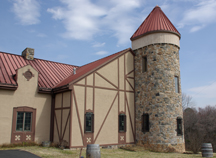 A first glimpse of Horton Cellars reminds one of a castle with the turreted tower on the side. Upon entering the building one proceeds to the right where the tasting room is located. To the side and back is a tasting bar. After introducing ourselves, we talked with a wine attendant who is very knowledgeable about wine in general and at Horton. Horton Cellars was started in 1988.
A first glimpse of Horton Cellars reminds one of a castle with the turreted tower on the side. Upon entering the building one proceeds to the right where the tasting room is located. To the side and back is a tasting bar. After introducing ourselves, we talked with a wine attendant who is very knowledgeable about wine in general and at Horton. Horton Cellars was started in 1988.
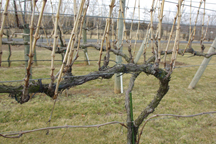 We began with a tour of the vineyard located in front of the tasting room. The trellising in this part of the vineyard uses an open lyre training system. Pruning takes place between November and March. Twenty to thirty nodes are left on the grapevines and the vines are given a final check in June. Pruning one acre of grapevines takes 40 hours. In this area it is important to have a good air flow to cut down on fungus. Currently Horton has over 100 acres with grapevines planted. Six hundred grapevines are planted per acre. Each plant will produce 16 pounds of grapes, depending upon the weather conditions. Horton produces 25,000 cases of wine.
We began with a tour of the vineyard located in front of the tasting room. The trellising in this part of the vineyard uses an open lyre training system. Pruning takes place between November and March. Twenty to thirty nodes are left on the grapevines and the vines are given a final check in June. Pruning one acre of grapevines takes 40 hours. In this area it is important to have a good air flow to cut down on fungus. Currently Horton has over 100 acres with grapevines planted. Six hundred grapevines are planted per acre. Each plant will produce 16 pounds of grapes, depending upon the weather conditions. Horton produces 25,000 cases of wine.
Our guide, Bill Bohn pointed out the rose bushes at the ends of each row of grapes. The purpose of the rose bushes is to help the vineyard manager know when a vineyard is having problems. The rose bushes will show a decline before the grapes show a decline. This gives the vineyard manager time to treat the problem before it devastates the vineyard. Mr. Horton, the owner, is also a viticulturist. Mr. Horton is responsible for bringing the Norton grape, a Virginia native grape, back to Virginia. During Prohibition Virginia lost all of its Norton plantings.
Six acres of the Georgian (Eastern Europe) grape Rkatsiteli are grown at Horton Cellars. The only other Georgian grape grown in the United States is in the Finger Lakes region of New York where six acres are planted.
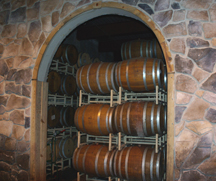
After the vineyard tour we walked along the side of the winery to the back where we entered the winery. Here we saw the inner workings of Horton's winery. The oaks barrels are behind a stonewall and can be seen through large arches. The barrels extend many feet beyond the front stonewall.
The tank room houses many large stainless steel tanks. We exited the tank room by using a set of winding stairs which gave us a good overall view of the tank room.
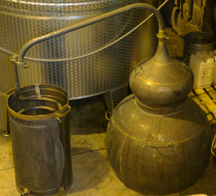
Also observed from this spiral stairway was a still, which can be used for making sherry. Our guide informed us that according to law wineries cannot make sherry at the same location where wine is produced. Therefore this particular still is not currently being used.
After the vineyard tour we returned to the tasting room and sampled several wines. Horton produces a wide variety of wines and fruit wines. The best selling wines at Horton Cellars are the Viognier, Cabernet Franc and Norton. Horton Vineyards has 37 wines to taste. You will have a chance to try wines that you may not have had before. Try the wine made from the Georgian grape, Rkatsiteli.
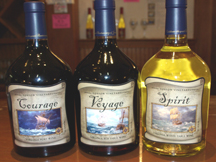 Most exciting are the wines that have been bottled for the 400 anniversary of Jamestown’s founding in 1607. Named the Commemorative Jamestown Series, Courage is a sweet port wine, Voyage is a dry red wine and Spirit is a dry white wine. The labels on these wine bottles have pictures of the three ships that made the voyage from England to Virginia. These bottles will make a great commemorative keepsake of the founding of Jamestown in 1607.
Most exciting are the wines that have been bottled for the 400 anniversary of Jamestown’s founding in 1607. Named the Commemorative Jamestown Series, Courage is a sweet port wine, Voyage is a dry red wine and Spirit is a dry white wine. The labels on these wine bottles have pictures of the three ships that made the voyage from England to Virginia. These bottles will make a great commemorative keepsake of the founding of Jamestown in 1607.
Horton Vineyards
Gordonsville, VA
GPS: N 38° 10.001’ W 078° 15.656’
Visit these Virginia wineries and wine tour groups that partner with Wine Trail Traveler.




